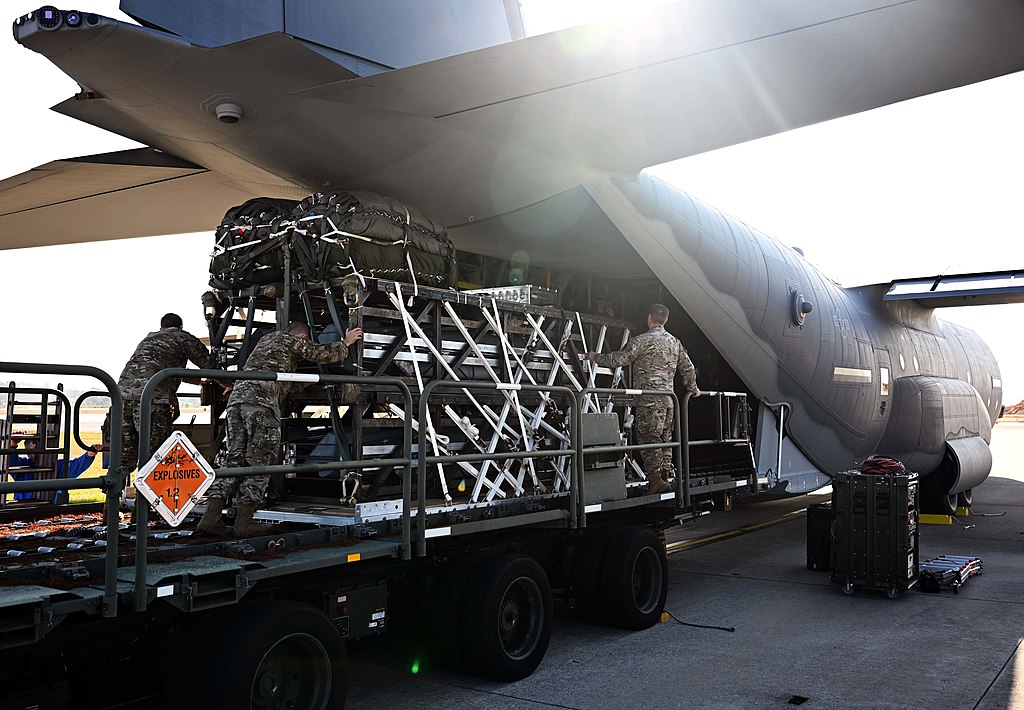George M. Moore

The Air Force’s Research Laboratory says that “Rapid Dragon is a palletized munitions experimentation campaign exploring feasibility and operational advantages of airdropping long-range palletized munitions from existing airlift platforms, such as the C-130 and C-17, without aircraft modifications.”[3] In standard English, Rapid Dragon converts cargo aircraft into weapons carriers that can deploy cruise missiles (and potentially other standoff or self-defense weapons) by releasing them on pallets via the planes’ rear cargo ramps. Such a system makes a cargo aircraft into the equivalent of a bomber. Potentially the cargo aircrafts’ weapons load is limited only by how many pallets will fit in the cargo bay.
In US military circles, there has been discussion of the potential impacts Rapid Dragon can have on increasing the level of conventional threat that potential adversaries, particularly China, will have to deal with. But there has been little discussion about the implications of Rapid Dragon for future nuclear arms limitation talks, or what will happen to conventional balances of power on both the global and regional level once, as is certain to happen, other technically sophisticated nations develop their own such systems, perhaps even improving on the initial US concept.[4] The genie is now out of the bottle and will never return.
The potential to develop Rapid Dragon so it can deliver nuclear weapons does not seem to have received any attention. The AGM-86 Air Launched Cruise Missile (ALCM) is nuclear capable and currently deliverable by the B-52. It appears that nothing would prevent the Rapid Dragon deployment of the ALCM, turning any cargo aircraft capable of using Rapid Dragon into a nuclear delivery aircraft.
The potential to use Rapid Dragon for nuclear weapons delivery (and eventually this will occur) will create new issues when serious nuclear weapons limitation resume. Unlike some past arms control agreements that required elimination of launch vehicles, there is no way to negotiate a limitation on cargo aircraft with rear ramps.[5] Therefore, it appears clear that future arms limitation negotiations will need to focus on limitations on the number of warheads a party possesses and how to conduct verifiable inspections of the party’s stockpile.
A Rapid Dragon-like nuclear delivery system also has potential impact on nuclear relations with NATO and other potential regional allies. Since most—perhaps even all—of the principal alliance members and potential allies have cargo aircraft, the United States could consider a NATO-like sharing agreement under which, in times of crisis, palletized nuclear systems could be loaded (perhaps with a US-controlled security and launch team) on non-US aircraft. In contrast to the current system, which requires potential non-US nuclear users to have nuclear trained pilots and qualified delivery aircraft, a palletized system would require little to no additional training or cost for the host/user nation. In the long run, such palletized systems might be seen as superior to the current NATO system of pre-positioned nuclear gravity bombs.
The potential for nuclear launch from cargo aircraft creates new tactical problems that could affect survivability and deterrence concepts. Wide dispersal of potential palletized nuclear weapons in time of crisis is somewhat akin to the problems that mobile launchers for missile systems create for an adversary. How can an aggressor locate enough of the potential weapons and launch vehicles to ensure the success of a first strike, and how survivable are the possible cargo aircraft to ensure the viability of a retaliatory strike?
Another factor that seems to have been ignored in the considerations of how Rapid Dragon will potentially strengthen US conventional capabilities is a discussion of what impact the inevitable spread of the pallet deployment technology will have on the ability of US forces to defend themselves in hostile environments. It is the flip side of the coin. Will a US carrier battlegroup now need to be able to respond to attacks much further from a potentially hostile shore? Note that cargo aircraft have far longer ranges than many of the current attack aircraft of most adversary states; a system like Rapid Dragon may result in significantly expanding the threat envelope posed by a hostile state.
Some may suggest that the detection of cargo aircraft is far simpler than that of conventional attack aircraft. With no stealth capability and limited, if any, ability to protect themselves,[6] current cargo aircraft might be easy to defend against. However, should the cargo aircraft fly at very low altitudes, detection and the ability to engage them may not be easy.
Once a potential enemy has Rapid Dragon-like systems, there may need to be a total rethinking of the United States’ current concepts for use of conventional forces in many areas of the world.
Rapid Dragon will be a game-changing concept for conventional and, possibly, nuclear weapons use, now for the United States and its allies, but in the future for potential US adversaries. The Rapid Dragon development is somewhat reminiscent of England’s introduction of the Dreadnaught, a type of battleship that made the rest of its large fleet obsolescent and allowed other nations to compete with England in building modern battleships. Rapid Dragon appears to be a similarly game-changing development for the United States and its allies but will need to be carefully monitored to ensure that the advantage it creates is maintained. Similarly, the nuclear potential for Rapid Dragon-like systems will need to be tracked, arms limitation strategies for such systems developed, and the potential increase in threat potentials and/or new threat vectors defined as counterstrategies are conceived
No comments:
Post a Comment